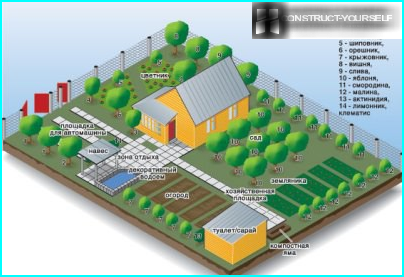
The first meet the beginning of spring bulbs. They bloom in April, when the perennials are still just waking up from hibernation. Therefore, in every flower there is at least a couple of bulbous primroses, quickening the dull landscape beds and give a spring mood. Of course, I want maximum brightness and abundant flowering for a long time, but it depends on the correct selection of varieties. Some bulbous perennials have a very short flowering phase and quickly disappear. Others do not tolerate excess may rain, large inflorescences wet and broken, so that is also a particular aesthetic does not work. Therefore, when buying bulbs it is necessary to pay attention to the flowering period of the varieties, resistance to weather conditions prevailing in your area, and ease of care.
The contents
Flowering period: the longer the better
Since onion is grown solely for the beauty of the blossoms, it would be desirable to extend the phase longer. And this is possible if correctly to plant plants. Many varieties accelerate the flowering period, growing up on the Sunny side and, on the contrary, slow the process of decay while in the shade. Such properties are particularly apparent tulips, crocuses, gladioli and lilies. Therefore, they should not be planted on sites where the whole day is Sunny. It is better that in the first half of the day (when very much sun cooks) these plants were in partial shade.
In addition, different plants differ in the duration of flowering. For example, colourful tigridia releases in the summer from each one inflorescence bulblets, which lives only 8 hours, and then immediately fade. So vacationers who come to the site only on weekends, can not see this happy moment. However, if you plant a group tigridia, they will not bloom all at once, but it is a little changes the overall picture.

Tigridia in group plantings looks great, but each flower lives for only 8 hours, and then immediately fade
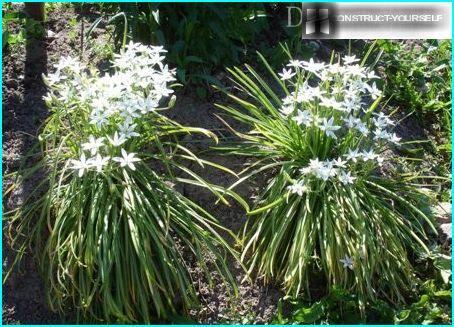
The flower arrows of prizemleniya grow gradually, making your way among the thin, long leaves, so the plant is happy beautiful flowers for about a month
The most «LP» spring bulbs colors include:
- anemone (blooms about 3 weeks);
- Royal grouse (2-3 weeks of flowering);
- Tulip (will have flowers up to 3 weeks depending on location);
- Narcissus (blooms more than 10 days).
Summer «centenarians» in terms of flowering are prizemleniya, freesia, some varieties of lilies.
The best flower bulbs for the garden for ease of maintenance
The second criterion for choice bulbs, which are guided «lazy» gardeners, is the degree of care of plants. The less hassle with them, the better they grow.
Many bulbs require annual digging after the death of the aerial parts. If this is not done, then the bulbs will become smaller, until the «no» either will freeze in the winter. To such demanding «handsome» are varietal tulips (especially of unusual colour and parrot Lily), gladiolus, freesia, hyacinths. So if you do not want to dig up, dry and to create the conditions for storage will have to do less demanding varieties.
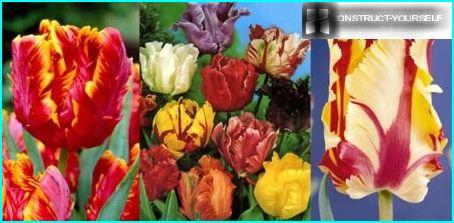
The unusual beauty of parrot Tulip varieties require special conditions for growth: annual digging, proper storage and several dressings
So, on one place for 3-4 years successfully grow lilies, daffodils, crocuses, all kinds of decorative bows, anemones, crocosmia, Royal grouse, Muscari.
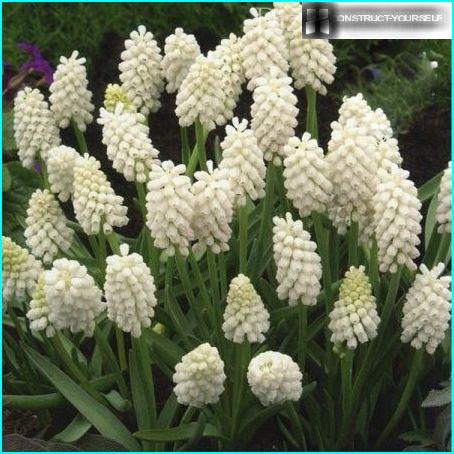
Muscari, or vetch, is very unpretentious, grows on one place for a few years and is rapidly propagated by division of bulbs and seeds
Plants that need special conditions
In the pursuit of growing large buds, breeders do not always take into account the thickness of the stem. Many new varieties of onion have huge flowers, but thin stems. This, of course, looks gorgeous in the flower bed when the weather is warm and calm. But if at the time of flowering will be the rainy season or strong wind will rise, the beauty will instantly fall to the ground, because the thin stems not withstand rocking or wet potjazhelevshie inflorescences. This occasion can occur with many varieties of Terry daffodils and freesias.
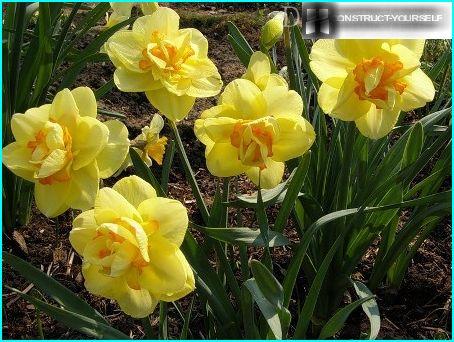
The more petals, in the inflorescence Terry Narcissus, the faster it gets wet and weighs a heavy fine flower arrow
Often broken and gladioli, but not because the stem is weak. On the contrary, powerful floral arrow with an abundance of large blossoms becomes a heavy burden for the bulbs. And that is the starting point of growth of the stem is breaking during windy weather. Therefore, many plants with high stalks have to be tied up as soon as you start to produce flower stalks. You can, of course, immediately planted bulbs at the net or the fence, but there is a place not at each site. By the way, very close «relative» gladiolus – atsidantera – is not afraid of the wind. However, the flower produces just one.
Flowers-soloists: who is good in single crop?
When making flower beds bulbs can act both as soloists, due to high growth and large blossoms and background. The highest are the gladioli, some varieties of lilies, atsidantera, crocosmia. But if the Lily is good in a single landing, then the rest it is better to plant small groups, because their stems are narrow and exposed to the beginning of the inflorescence.
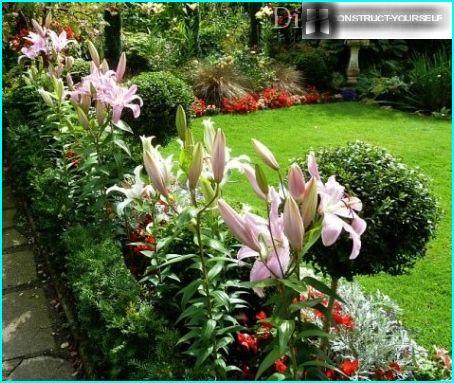
The beauty of the lilies and their high growth argue not every flower in the garden, so that they are allocated the best seats in the flower beds
Well look in the center of the flower beds of the Royal grouse. However, to match it with the background quite difficult. These bulbs bloom one of the first. But among the conifers, creeping perennials, climbing plants and decorative bows, they look really Royal. But if you plant in a group with Lily, while she will gain strength and growth, the grouse will have time to wither and get lost at all, giving way to his followers.
Article topic: Planting bulbs in the fall: General rules + review of the best 6 varieties
Ornamental onions (Allium): beautiful in group plantings
A large group of bulbous plants for the garden are decorative bows. Their selection of over 150 varieties, but for some reason in the design of the flowerbeds Allium use much less tulips or gladioli. But in vain! These plants are very compact, forming a shrub tubular leaves, and the number of flowers on a single plant reaches 60 pieces. Ornamental onions have a long growing season, so all spring and summer will be beautiful, even if the flowering period has not yet arrived. Varieties differ in flowering time. Early bows begin to bloom by mid-may and late – in late August, the duration of flowering is a month or more.
These bulbs are good to make the edge border, the lower tiers in multi-step flower beds, to include in the mixed borders. And, for example, a variety of chives can also be eaten. In the spring it thin tubes climbs out of the ground very early, even ahead of winter bow, so you get double the fun and aesthetic, and food.
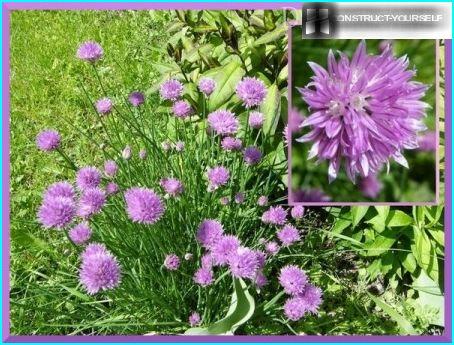
Chives, onions, whose feathers you don’t have time to eat in early spring, will issue by the summer of the beautiful purple beads and buds, decorated garden bed or flower bed
Bold and unpretentious novelties
Bulbs that inhabit most of the flower beds, the well-known: tulips, lilies, gladioli, daffodils, snowdrops. But such names as Gemini or montbretsiya known is that onion lovers of the exotic. We do not buy new products, afraid of the difficulties of care, although these plants just special problems then and there.
Gemini: an alternative to conventional gladioli
The term «Gemini» referred to as a miniature gladiolus, the height of which does not exceed two feet. They bloom much earlier and, in contrast to the giant «fellow», warp or creep from the wind. Such varieties are grown in the open ground and on the balconies. The only negative is the annual farming for the winter and store in the refrigerator.

Colors and varieties of Gemini not less than that of conventional gladioli and windy weather and the rain they carry much better
Montbretsiya: gladiolus from Japan
Montbretsiya known to most gardeners as the crocosmia (or Japanese gladiolus), which moved from a wild habitat in gardens. But in reality, montbretia was the result of breeding crocosmia, so to speak, its cultural form. The inflorescence has a much larger, and the orange color added red and yellow. However, the novelty has ceased to be hardy and requires digging for the winter. But her wild sister winters well even in the harsh climate.
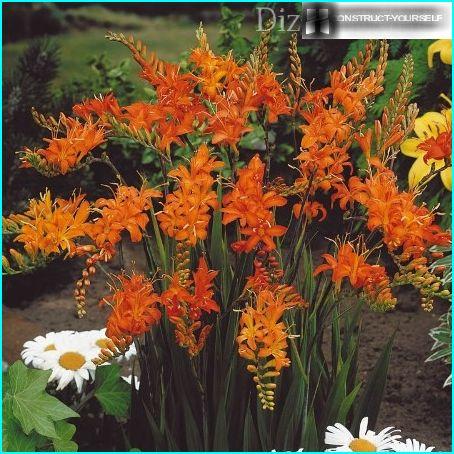
A few bulbs of montbretii planted around, form a beautiful tall Bush that can become the center of any flower garden, because long-lasting decorative
When choosing bulbs for your own garden, be guided not only by the beauty and amount of inflorescences, but also on the adaptation of the plant to the conditions of your garden. The grouse may not bloom if the ground is too poor, and the summer – arid.






